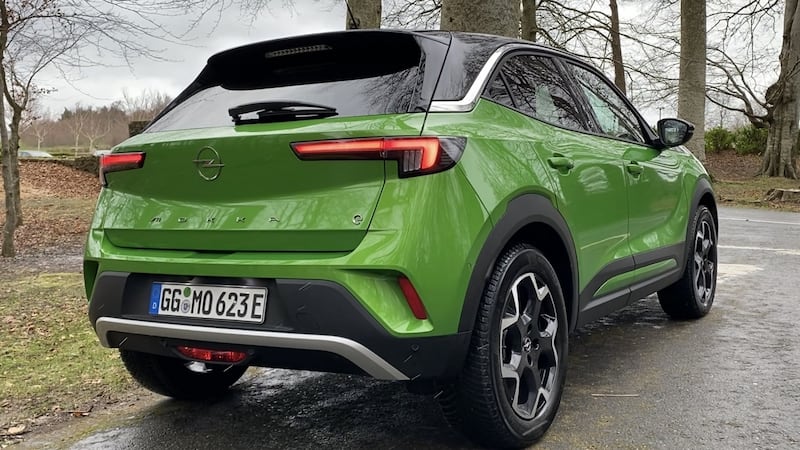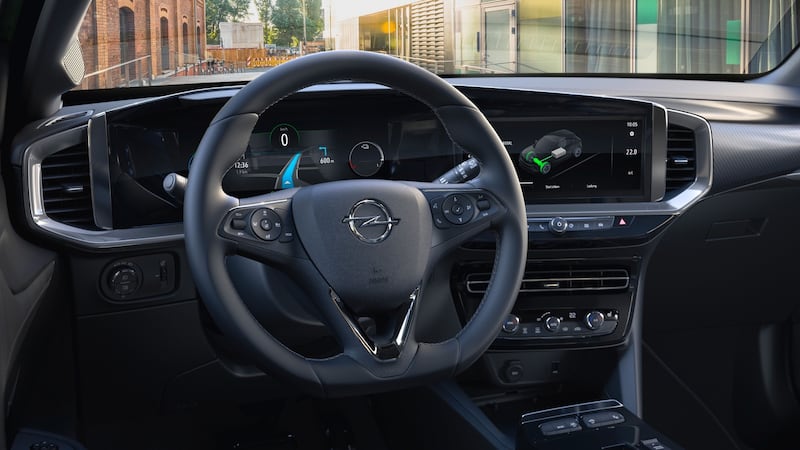In a world of pandemic grey, a Paddywagon green car is always going to stand out. And Opel is out to make a statement with its new Mokka. For a brand that has been battered and bruised by corporate upheaval for the last decade or more, it's a pretty brash move. But a very welcome one.
This was, perhaps, not supposed to happen. After all, when Opel joined forces with what was then the PSA Group – and which with the shotgun marriage to Fiat has now become Stellantis – it seemed to have a different role. The French would make the stylish, avant garde cars and Opel would make the sensible-shoes stuff.
With the new Mokka, green paint or otherwise, that idea seems to have been kicked for touch. Put the new Mokka up against its direct French relatives – the Peugeot 2008 and the Citroen C3 Aircross. While the 2008 has definite panache, the Mokka has a certain 1970s retro appeal.
You can see why Opel is eager to evoke memories of a time when it was cutting edge and on a roll. The Mokka’s styling touches act like a corporate comfort blanket, but clearly they strike a chord with car buyers too. The excitement over a potential return of Opel’s glorious Manta from that era is proof of an ongoing public affection for cars from its most recent heyday – and forgiveness for several mistakes since then.
Seventies era cars
Viewed through the kaleidoscope of seventies era cars, you can really appreciate some of the new Mokka’s design traits. It gets Opel’s new front nose (1970s Opel Ascona perhaps?), which features a black, blank, grille with the Opel lightning bolt at the centre, and crisp styling down the sides and around the back. The use of chrome doesn’t quite work, but the rest of the Mokka – especially the black bonnet of our sporty SRI test car that’s a reference to 1970s Manta coupés – is rather handsome.
The new car is also be well-priced. Opel Ireland has not yet finalised pricing for the Mokka, but it should start from €23,500 for the 1.2-litre petrol model when it arrives in April, rising to €33,000 for the SRI-spec electric Mokka-e that we’re testing here.
Opel shipped a couple of left-hand drive German registered cars to Dublin for a quick spin ahead of the official spring launch. A time for renewal and restart, it’s fitting for Opel as this Mokka-e feels like a big step forward.
That’s most apparent in the cabin. The Mokka gets Opel’s new “Pure Panel” setup, which is a fancy way of saying that it has two screens – the centre screen, which optionally expands to 10 inches across, is for your navigation and infotainment, while the big 12-inch screen in front of the driver is for the instrument panel. Opel, being Germanic and sensible, has also kept proper physical controls for the heating and air conditioning.

The cabin’s build quality is good, though some of the harsh hard plastics on the dash let it down at a time when other brands are embracing more natural materials for their cabin trims. Space is also a touch tight. It’s ample up front, but the rear is a slightly tighter squeeze for legroom and headroom, and this electric Mokka-e loses 40-litres of boot space compared to the petrol version, offering only 310-litres.
It does compensate with decent range, though. According to the WLTP test, the Mokka-e’s 50kWh battery can power it for up to 324km on a single charge. Oddly, that more than the 310km quoted for the mechanically (and battery-ally) identical Peugeot e-2008.
Steering differences
To drive the two cars are, unsurprisingly, alike, but there is nuance to be mined. Chiefly, that’s in the steering where Opel’s bigger, rounder wheel (compared to the Peugeot’s tiny, hexagonal one) means that the steering feels more natural. The Peugeot arguably feels a little sportier, but the Opel would probably be the sweeter to drive over a long distance.
The ride quality is fine – firm, but acceptably so – and the Mokka does a better job of coping with the extra 300kg of battery weight than does the smaller Corsa.
Our biggest gripe was with the brake pedal, which felt spongy and unresponsive. It really lets the side down, and there’s almost none of the “one pedal” sensation that you get from the stronger regenerative braking of rival models.
None of the instant-torque feeling of rivals, either – as with the Peugeot, the Opel’s 136hp electric motor has been set up to feel linear, and more like a combustion engine. That may aid the transition to battery power for some, but it does feel as if the Mokka is missing the party trick of some others.
Opel’s decision to offer the Mokka in petrol, diesel and electric shows it’s still committed to trying to cover all the customer bases on the Irish market, sensitive to the fact that for many of its rural customers, range concerns is still a barrier to buying electric.
Battery range
One of the biggest drains on battery range is the energy used to preheat the car and the battery pack when starting out. That’s where home chargers come into their own, and why many companies point their users to the dedicated smartphone apps that are often linked to electric cars. A feature of most of these is the ability to you set a departure time and thereby pre-heat the car while it’s still on the home charger.
As for home chargers, Opel has done a deal with Energia so Mokka buyers who switch to that electricity provider have all the costs for the home charger covered.

With only a brief spell behind the wheel, and that on the wrong side of the car, that’s about as much as we can tell you for now.
Will that range hold up? Yes, probably, as long as you don’t spend hour after hour on the motorway. The cold weather does play havoc with your range, though.
Is it good to drive? Yes, almost surprisingly so. Is it stylish? Yes, and that’s really surprisingly so.
Good value? Well … yes, as it will likely undercut an equivalent e-2008 by a little, but it isn't all that much cheaper than a Hyundai Kona Electric, which offers around 100-120km more range on a single charge.
Still, it’s hard to see the new Mokka as anything but a bit of a triumph for once-beleaguered Opel. It looks and feels like a confident, modern product, and that’s a very good sign for the brand’s future. Just maybe think about your colour choice (there are several options): will you be delighted to be greeted on your driveway every morning by a bright green car?










